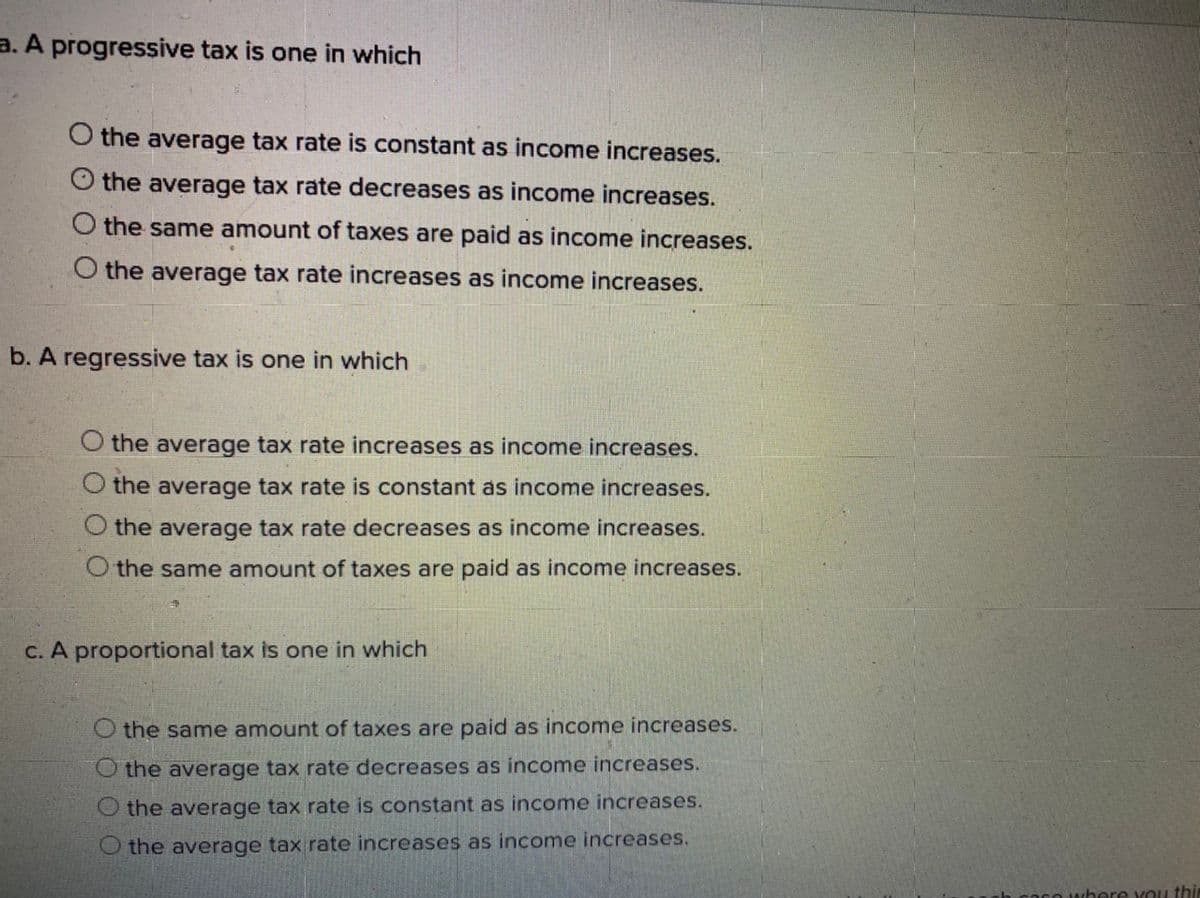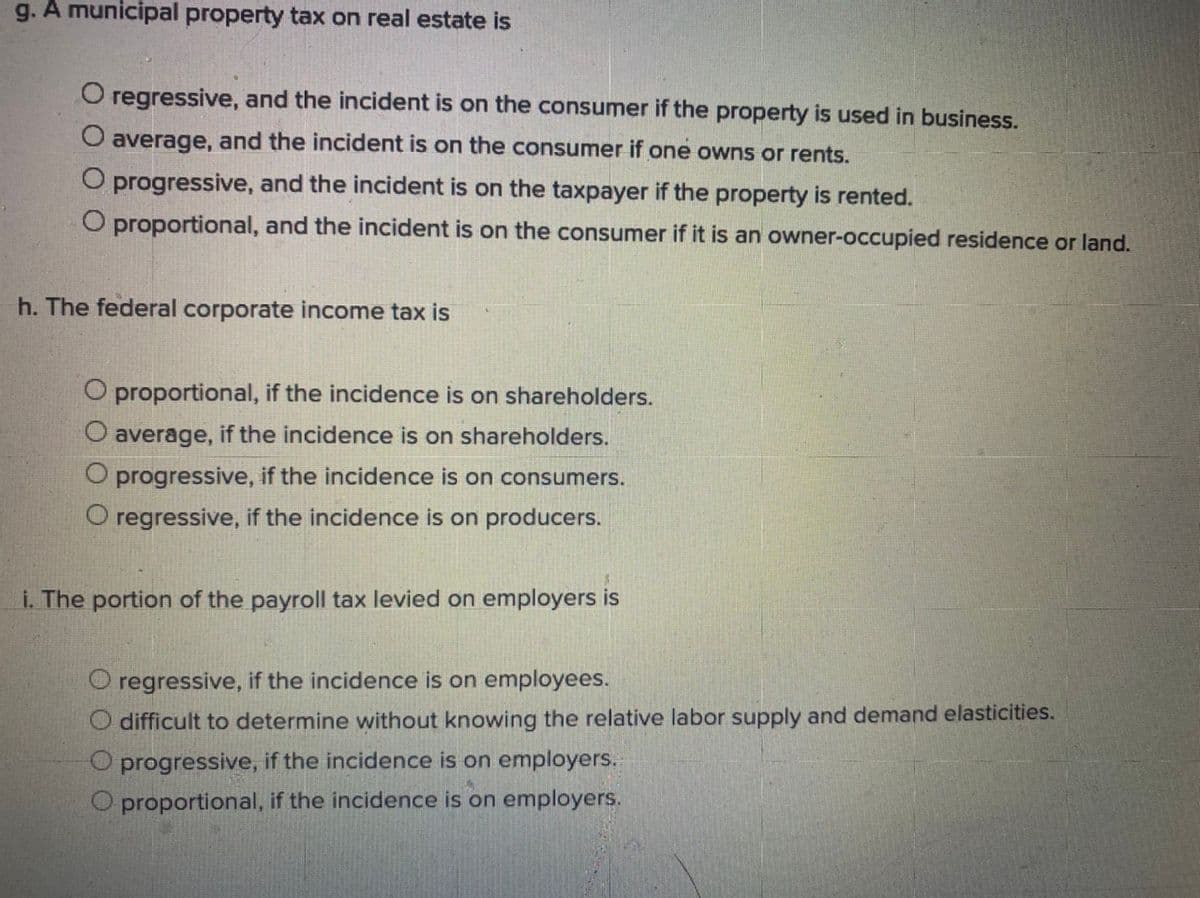a. A progressive tax is one in which the average tax rate is constant as income increases. O the average tax rate decreases as income increases. O the same amount of taxes are paid as income increases. O the average tax rate increases as income increases. b. A regressive tax is one in which O the average tax rate increases as income increases. O the average tax rate is constant as income increases. the average tax rate decreases as income increases. O the same amount of taxes are paid as income increases. C. A proportional tax is one in which O the same amount of taxes are paid as income increases. O the average tax rate decreases as income increases. O the average tax rate is constant as income increases. O the average tax rate increases as income increases.
a. A progressive tax is one in which the average tax rate is constant as income increases. O the average tax rate decreases as income increases. O the same amount of taxes are paid as income increases. O the average tax rate increases as income increases. b. A regressive tax is one in which O the average tax rate increases as income increases. O the average tax rate is constant as income increases. the average tax rate decreases as income increases. O the same amount of taxes are paid as income increases. C. A proportional tax is one in which O the same amount of taxes are paid as income increases. O the average tax rate decreases as income increases. O the average tax rate is constant as income increases. O the average tax rate increases as income increases.
Economics (MindTap Course List)
13th Edition
ISBN:9781337617383
Author:Roger A. Arnold
Publisher:Roger A. Arnold
Chapter11: Fiscal Policy And The Federal Budget
Section: Chapter Questions
Problem 5WNG
Related questions
Question
Q

Transcribed Image Text:a. A progressive tax is one in which
O the average tax rate is constant as income increases.
O the average tax rate decreases as income increases.
O the same amount of taxes are paid as income increases.
O the average tax rate increases as income increases.
b. A regressive tax is one in which
O the average tax rate increases as income increases.
O the average tax rate is constant as income increases.
the average tax rate decreases as income increases.
the same amount of taxes are paid as income increases.
C. A proportional tax is one in which
O the same amount of taxes are paid as income increases.
O the average tax rate decreases as income increases.
the average tax rate is constant as income increases.
O the average tax rate increases as income increases.
cO where You thin

Transcribed Image Text:g. A municipal property tax on real estate is
O regressive, and the incident is on the consumer if the property is used in business.
O average, and the incident is on the consumer if one owns or rents.
O progressive, and the incident is on the taxpayer if the property is rented.
O proportional, and the incident is on the consumer if it is an owner-occupied residence or land.
h. The federal corporate income tax is
proportional, if the incidence is on shareholders.
O average, if the incidence is on shareholders.
O progressive, if the incidence is on consumers.
O regressive, if the incidence is on producers.
i. The portion of the payroll tax levied on employers is
O regressive, if the incidence is on employees.
O difficult to determine without knowing the relative labor supply and demand elasticities.
O progressive, if the incidence is on employers.
O proportional, if the incidence is on employers.
Expert Solution
This question has been solved!
Explore an expertly crafted, step-by-step solution for a thorough understanding of key concepts.
Step by step
Solved in 2 steps

Recommended textbooks for you

Economics (MindTap Course List)
Economics
ISBN:
9781337617383
Author:
Roger A. Arnold
Publisher:
Cengage Learning


Microeconomics: Principles & Policy
Economics
ISBN:
9781337794992
Author:
William J. Baumol, Alan S. Blinder, John L. Solow
Publisher:
Cengage Learning

Economics (MindTap Course List)
Economics
ISBN:
9781337617383
Author:
Roger A. Arnold
Publisher:
Cengage Learning


Microeconomics: Principles & Policy
Economics
ISBN:
9781337794992
Author:
William J. Baumol, Alan S. Blinder, John L. Solow
Publisher:
Cengage Learning

Brief Principles of Macroeconomics (MindTap Cours…
Economics
ISBN:
9781337091985
Author:
N. Gregory Mankiw
Publisher:
Cengage Learning

Principles of Macroeconomics (MindTap Course List)
Economics
ISBN:
9781285165912
Author:
N. Gregory Mankiw
Publisher:
Cengage Learning

Principles of Macroeconomics (MindTap Course List)
Economics
ISBN:
9781305971509
Author:
N. Gregory Mankiw
Publisher:
Cengage Learning